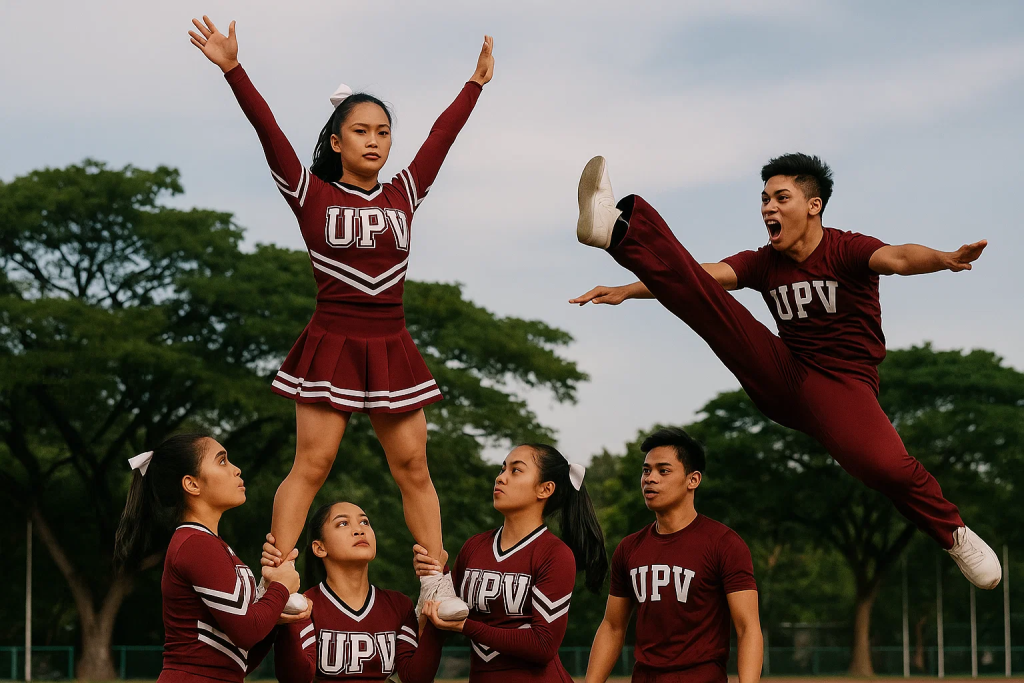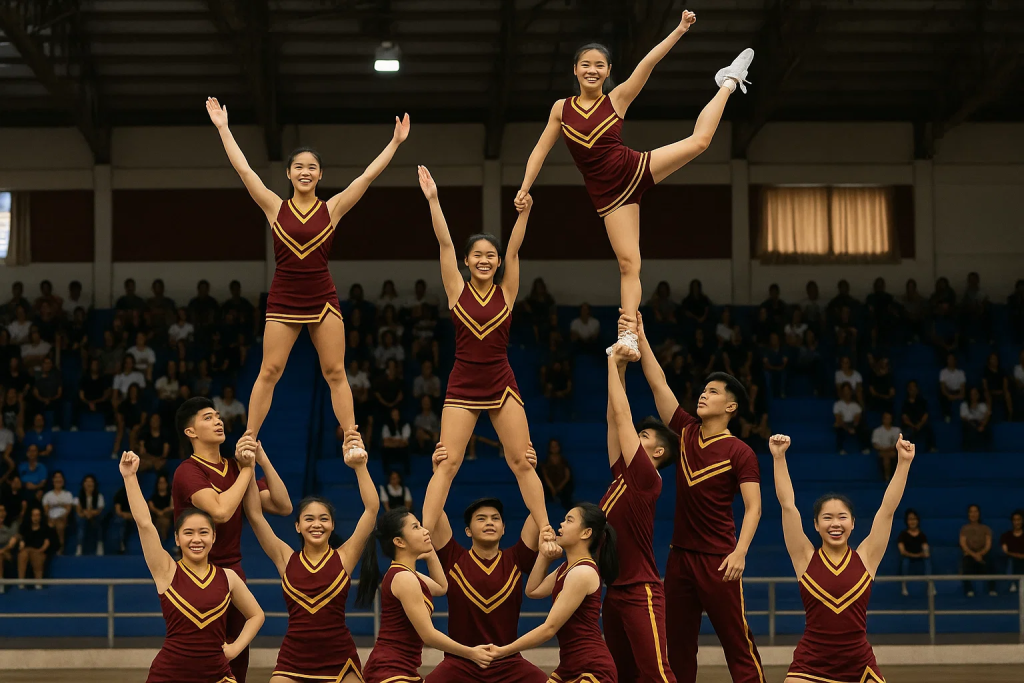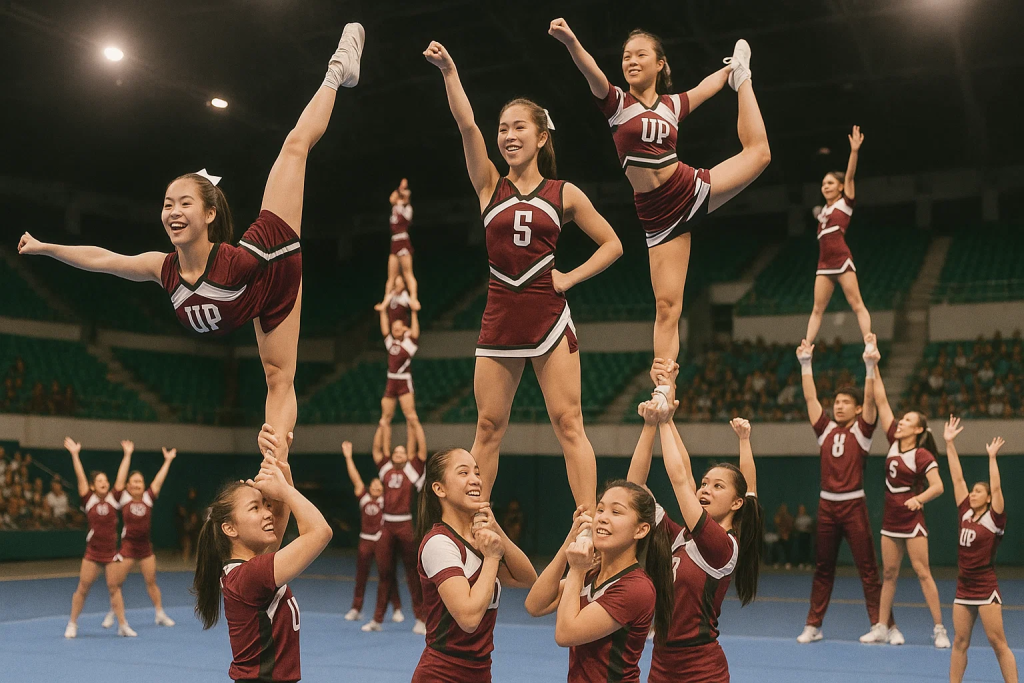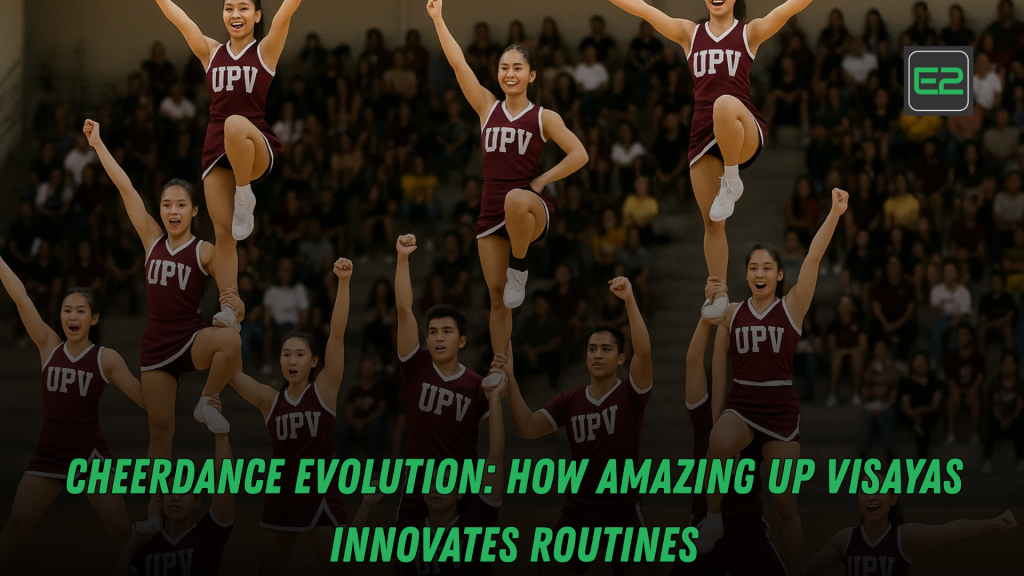Table of Contents
Why “innovation” now defines cheerdance
In the last decade, cheerdance in the Philippines has moved from sideline hype to center-stage spectacle. Routines are tighter, transitions smarter, and choreography increasingly tells a story—not just about athleticism, but about identity. Within this shift, UP Visayas (UPV) stands out for evolving cheerdance in three key directions:
- Cultural fusion: weaving Visayan/Hiligaynon elements—rhythms, gestures, and motifs—into stunts and dance breaks.
- Methodical training: data-guided progressions, safer technique, and a “film-room” mentality.
- Digital-first storytelling: releasing teasers, behind-the-scenes clips, and crowd-sourced moments to feed the algorithm and the audience.
This article is your long-form, guide to what that evolution looks like in practice: how to design innovative routines, train them safely, build an audience, and measure what works. Whether you’re a coach, team captain, dancer, production lead, or a curious fan, you’ll find checklists, templates, and strategy you can apply immediately.

Cheerdance evolution: from chants to choreography to cultural narrative
Cheerdance began as structured chants to energize crowds. Over time, squads layered in jazz technique, street grooves, acro stunts, pyramids, and prop-based visuals. Today, the differentiator is cohesion: the best routines look like short films you can watch on loop, where music cues, levels, and storytelling drive the audience’s emotions.
What sets UP Visayas apart is how that storytelling is rooted in place. The routines nod to iloilo festivals, Panay-Bukidnon rhythms, coastal imagery, and even everyday kinetics (paddle, weave, harvest) reimagined as counts, lifts, and ripples. The result: a style that is recognizably UPV—athletic, intelligent, and culturally grounded.
What “innovation” means in a UP Visayas routine in Cheerdance
To “innovate” is not only to add a bigger toss or steeper pyramid. In the UPV lens, innovation blends art direction, biomechanical safety, and audience psychology:
- Music architecture: a score that breathes—intro hook → tempo lift → cultural break → stunt peak → “silent snap” reset → finale hit.
- Cultural flourishes (not gimmicks): authentic footwork patterns, scarf/fan/banig props, or kulintang-inspired percussive accents that serve the narrative.
- Safer difficulty: progressions prioritize consistent mid-air shapes and clean cradle timings over “one-time miracles.”
- Transition intelligence: pathways that minimize traffic and maximize picture changes; the routine looks complex without becoming chaotic.
- Audience hooks: a signature UPV motif (e.g., a paddle-to-wave arm ripple) repeated in three ways: small (solo), medium (line), large (full-squad cannon).
Anatomy of a modern UPV-style cheerdance routine
Below is a blueprint you can adapt. Times assume ~2:30–3:00 runtime.
- Opening image (0:00–0:10)
- Goal: Instant brand stamp. Use a still tableau (levels!) then a snap to motion.
- Tip: Build a silhouette the audience can photograph.
- Velocity warm-up (0:10–0:35)
- Fast footwork + sharp arms; announce musicality and cleanliness.
- Drop an Easter egg: a mini cultural step the crowd will recognize later when it returns larger.
- Partner stunts set 1 (0:35–1:00)
- Skill ceiling with safety: pre-decided shape library (liberty → arabesque → heel stretch).
- Visual trick: mirror pairs that “crossfade” through center for a camera-friendly moment.
- Cultural dance break (1:00–1:25)
- Authenticity first: study source movements; adapt counts without parody.
- Props? Keep them light, safe, and secured (elastic loops, soft edges).
- Pyramid 1 + cannon (1:25–1:45)
- One pyramid, two heights. Add a cannon ripple (Row A hit 1-2, Row B hit 3-4…).
- Rule: callouts in rehearsal—“top lock,” “eyes front,” “cradle ready.”
- Tumbling pass (1:45–2:00)
- Staggered diagonals to prevent collision; high-percentage skills over heroics.
- Insert a “silent snap”—music dips, team freezes, one beat of silence, then drop the bass.
- Partner stunts set 2 → feature toss (2:00–2:20)
- Escalation: same shape family, new entry/exit.
- One feature toss placed on a downbeat with clear spotters’ cue.
- Finale: pyramid 2 + crowd chant (2:20–end)
- Build the tallest picture, then lock. Overlay a Visayan chant hook the crowd can clap to.
- End with a level-stacked logo pose (center eye line, open chests, angles tight).
Safety in Cheerdance is an innovation: UPV’s progression-first mindset

Chasing difficulty without systems is not innovation—it’s risk. A hallmark of the UPV approach is boring brilliance: repeatable progressions until muscle memory frees the mind for performance.
Safety pillars you can copy:
- Shape library: codify shapes and names (e.g., “Arrow,” “Sail,” “Wave”), post diagrams, drill under fatigue.
- 3-step stunt pathway: master on ground → master in static hold → add dynamic entry/exit.
- Red-flag protocol: any missed catch = automatic reset to the preceding progression for three clean reps.
- Spotter choreography: spotters are not wallpaper; they are choreographed. Assign sightlines and verbal cues.
- Crash-mat culture: early weeks on mats, then staged removal; never rush to floor.
- Load management: track landing counts per athlete (jumps, tumbling, cradles) to avoid overload spikes.
The UPV “film room”: data and video as training tools
Innovation also means treating rehearsal like an edit suite. UPV-style prep uses video loops, slow-mo, and annotation after each run:
- Run → Review → Re-run cycles with two focal points per cycle (e.g., “left base hip height” and “center line spacing”).
- Retention charts: how many clean hits per element? Celebrate consistency, not just peak skill.
- 8-count maps: a printable grid of the routine with colors (green = clean, yellow = shaky, red = retry).
- Camera choreography: pre-plan close-ups (featured flyers) and wides (formations) for content day; design transitions that look good on camera, not just live.
Cultural fusion without caricature
Cultural borrowing becomes innovation when it is researched, respectful, and purposeful. A UPV-inspired process might look like this:
- Source study: meet local practitioners (dance troupes, cultural groups); learn context and etiquette.
- Movement translation: pick specific motifs (foot taps, hand waves, body tilts) and convert them into countable patterns (1-and-2-and).
- Prop protocol: if using fans/scarves/banig, keep dimensions performance-safe; rehearse catch/hand-off counts.
- Narrative fit: embed motifs where the music supports them; let percussion align with foot patterns.
- Credit and gratitude: acknowledge inspirations publicly (program notes, captions, shoutouts).
- Audit for tone: remove anything that reads as costume-y or comedic if the goal is respect.
Music direction: build a score that “breathes”
Great routines feel inevitable because the music leads. UPV-inspired scoring tips:
- Hook within five seconds: a chant, a percussive hit, or a sampled line in Hiligaynon that matches your hand ripple.
- Dynamic range: not all loud, not all fast—use quiet valleys to prime the audience for the next punch.
- Motif return: reintroduce your opening hook near the end in a bigger form (choir stack, extra percussion).
- Percussion under stunts: light taps help the team keep time without drowning spotter cues.
- Legal audio: clear rights or use licensed/performance-safe stems; avoid last-minute copyright surprises.
Formation design: “picture changes” that feel like magic
The audience reads geometry even if they don’t know they do. Use these rules:
- Rule of thirds: place feature action off center for visual tension, then snap to center on the hit.
- High–mid–low layering: create depth so cameras always have interesting planes.
- Traffic maps: draw arrows for dancer paths; rehearse with cones/tape to avoid mid-field collisions.
- Mirrors with meaning: if your theme is “waves,” mirror lines can crest and break; let choreography echo the story.
Social + stage of Cheerdance: designing for both the arena and the algorithm
UPV’s digital-first mindset accepts a truth: more people will see your routine on screens than in the arena. That’s not a threat; it’s leverage.
Make content moments on purpose:
- 3 signature shots: (1) opening tableau reveal; (2) mid-routine “silent snap”; (3) finale lock with confetti or scarf-wave.
- Vertical cutaways: choreograph one diagonal pass specifically for vertical crop (9:16).
- Behind-the-scenes (BTS): mic a coach for a 30-sec pep talk; film “first time the pyramid hit” reactions.
- Audience participation: teach a two-count clap on socials a week before the event so the crowd becomes part of the routine.
- Caption playbook: include names, counts, and a “try the clap” CTA; add localized hashtags (e.g., #Iloilo, #UPV).
Cheerdance Practice calendar: an 8-week UPV-style build
Week 1–2: Foundation & vocabulary
- Conditioning, flexibility screens, shape library basics, no stunts above prep level.
- Music rough cut; 8-count mapping begins.
Week 3–4: Elements in isolation
- Partner stunts set 1, cultural footwork drills, prop handling.
- Start filming all runs; install safety language and spotter cues.
Week 5: Transitions & pyramid 1
- Traffic rehearsals; timing cannons; first full-music run (two “film room” sessions).
Week 6: Tumbling pass, feature toss, pyramid 2
- Vertical-friendly diagonal; crash-mat volume managed.
- Inject “silent snap” and test live reaction with small audience.
Week 7: Polishing & camera choreography
- Final music edit; social content day (BTS, teasers, stills).
- Dress rehearsals with props, makeup, and lighting tests.
Week 8: Taper & performance
- Fewer landings, more visualization, cue-only run-throughs.
- Post-performance debrief; capture encore takes for highlight reels.
Budget-smart innovation in Cheerdance (because resources matter)
You don’t need unlimited funds to look premium:
- Smart props: fabric fans, light scarves, foam rods—cheap, safe, and photogenic.
- DIY staging: LED strips and battery puck lights tape to the floor (outside performance area) for pre-show visuals.
- Uniform hacks: consistent color story > expensive pieces. Add arm bands or sash to tie the cultural palette.
- Community partners: borrow instruments/costume details through cultural groups—trade exposure + tickets for support (with respect and credit).
- Phone-first filming: a modern smartphone + gimbal + clip-on mic is enough for 90% of social content.
Judging criteria decode: how innovation scores
While score sheets vary, most rubrics include: difficulty, execution, creativity, synchronization, showmanship, and overall effect. UPV-style innovation maps like this:
- Creativity = cultural integration + transitions that surprise but make sense.
- Execution = clean lines, safe landings, steady shapes.
- Synchronization = counts that snap together—especially in footwork.
- Overall effect = a narrative the audience can feel and follow.
Pro tip: Trade 5% difficulty for 20% cleanliness if your hit rate drops. Judges reward what looks effortless.
Common pitfalls—and how UPV avoids them
- Too many tricks, not enough story: set a theme, then cut moves that don’t serve it.
- Prop chaos: if it clutters counts or risks safety, simplify or drop.
- Sound mush: over-layered audio makes cues unclear; protect your downbeats.
- Unrehearsed spacing: tape the floor; practice entrances/exits like choreography.

Sample 8-count (UPV-inspired cultural break)
Counts 1–8; music mid-tempo with light percussion.
- 1 step R diagonal, & tap L, 2 ripple arm (wave), 3 step L, 4 lift scarf to shoulder line,
- 5 hip tilt + half-turn, 6 scarf toss 45° micro (no release beyond eye line), 7 catch, 8 lock + head to audience.
Repeat with opposite lead; layer trios and a cannon on the third repeat for build.
Brand and community: make the routine bigger than one night
UPV’s model treats cheerdance as a year-round conversation:
- Member spotlights: weekly mini-interviews (Why you cheer? Favorite drill? Study hacks?).
- “Teach the clap” reels before events.
- Community classes: open footwork workshop; “parents’ day” to demystify safety.
- Alumni loop: create a cheer alumni chat for mentorship, job leads, and sponsorship bridges.
Template: one-page routine brief (copy & adapt)
- Theme: (e.g., “Waves & Wind—Coastline Spirit”)
- Palette: deep blue, seafoam, warm sand; scarf as prop.
- Motifs: arm ripple (wave), foot tap (oar), diagonal surge (wind).
- Signature shots: tableau reveal; silent snap; scarf-wave finale.
- Skill ceiling: prep→liberty→arabesque (consistent); 1 feature toss.
- Safety notes: mat weeks 1–5; landing counts per athlete; spotter cues scripted.
- Content plan: teaser (week 6), BTS (week 7), full highlight (week 8 + 24h).
- KPIs: clean-hit rate 85%+, average view duration 10s+, save/share ratio growth.
Cheerdance in the Philippines is shifting from sideline chants to story-driven, camera-ready productions, and UP Visayas (UPV) exemplifies this evolution. UPV innovates by fusing authentic Visayan motifs with clean, progression-based stunts, intelligent transitions, and music that “breathes.” The article outlines a modern routine’s anatomy—hooked opening, cultural break, two pyramids, staggered tumbling, a “silent snap,” and a chant-powered finale—plus safety pillars: shape libraries, red-flag resets, choreographed spotters, crash-mat culture, and load management.
Athlete Exodus: Nexplay Amazing Stars Leaving MLBB for New Games
A film-room approach uses video loops, 8-count maps, retention charts, and camera choreography to raise consistency and storytelling. Cultural integration follows research, respectful translation, prop protocols, and credit. Music direction, formation geometry, and vertical-first content create three signature moments for arena and algorithm. Playbooks include an 8-week build, a 30-day content calendar, KOL/KOC tactics, livestream tips, KPI dashboards, and sponsor packages. Budget hacks (light props, cohesive colors, phone kits) make premium looks accessible.
Judges reward creativity, cleanliness, synchronization, and overall effect; trade small difficulty for major cleanliness gains. Common pitfalls—prop clutter, sound mush, spacing errors—are addressed. Templates, a sample 8-count, and community programming extend impact beyond one night. The CTA invites squads to share goals and request a free routine-brief kit. Start now and lead Philippine cheerdance’s next chapter.
Call-to-action: Be part of the evolution
If you love cheerdance innovation—or you’re building a routine right now—drop a comment with your theme idea, biggest challenge, or safety question. Want a free routine brief template and 8-count map in editable format? Say “SEND THE KIT” and I’ll share a ready-to-use file you can customize for your squad. Share this guide with a coach or teammate—we’re building a smarter, safer, more creative cheerdance scene together.
FAQs: Cheerdance Evolution & UP Visayas Innovations
1) How can we incorporate local culture into cheerdance without it feeling forced?
Start with source research (folk-dance groups, cultural practitioners) to understand context and etiquette. Choose specific motifs (foot patterns, hand waves, body tilts) and translate them into clear countable phrases (e.g., 1-and-2-and). Place motifs where the music supports them, keep the meaning intact rather than just “borrowing the look,” give public credit to your inspirations, and be open to feedback from the community.
2) In judging, what matters more—difficulty or cleanliness?
Both matter, but clean execution usually determines the overall impression. If your hit rate falls below ~70%, step down one skill level to reach 85%+ consistency, because judges reward steady timing, safe landings, and stable shapes.
3) How do we film/edit so the routine performs well on social media?
Intentionally design three signature moments (opening reveal, mid-routine “quiet snap,” finale lock) for vertical formats. Add contextual captions (move names, counts), post behind-the-scenes alongside performance clips, and include a clear CTA (watch the full routine, learn the 8-count, join a workshop).
4) What practice schedule helps reduce injuries?
Use progressions: master skills on the ground → in static holds → then add dynamic entries/exits. Track landing counts per athlete, train on mats for the first five weeks, script spotter cues, schedule recovery blocks, and finish sessions with active stretching.
5) We’re on a tight budget—can we still look professional?
Yes. Choose light, safe props (scarves, fans), a cohesive color palette over costly uniforms, and budget lighting (LED strips/puck lights). A smartphone + gimbal + clip-on mic covers most content needs. Partner with local cultural groups to borrow items—offer credit and complimentary tickets in return.
